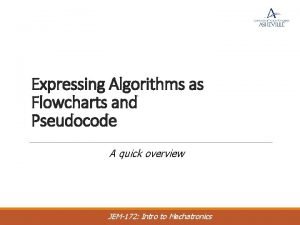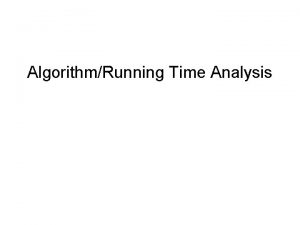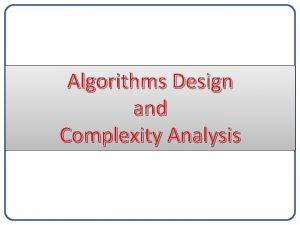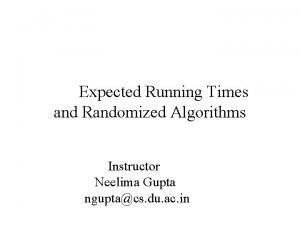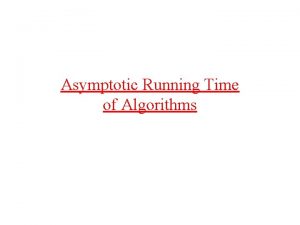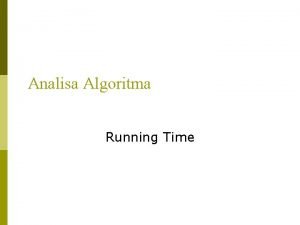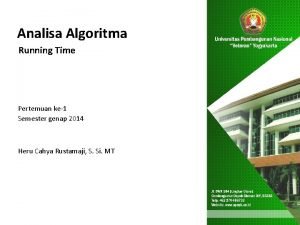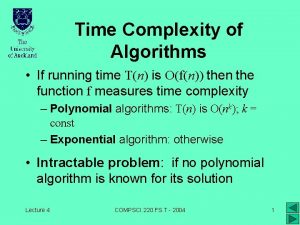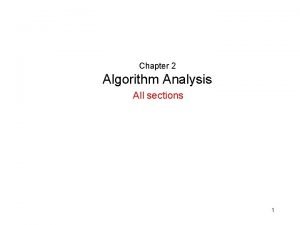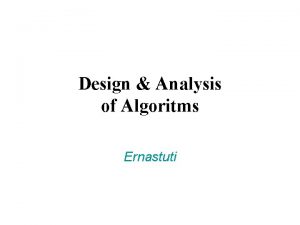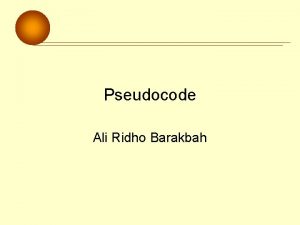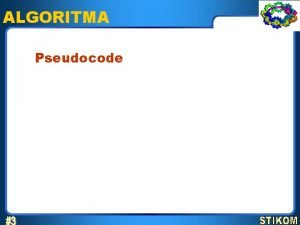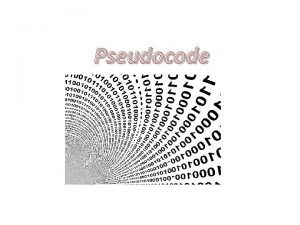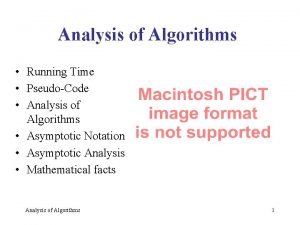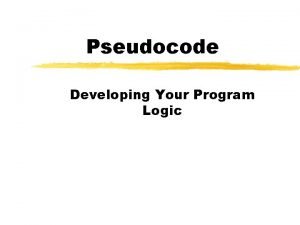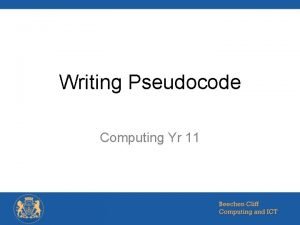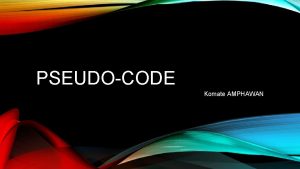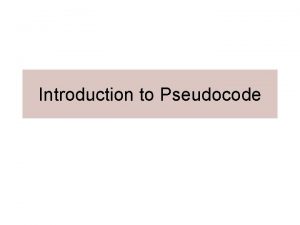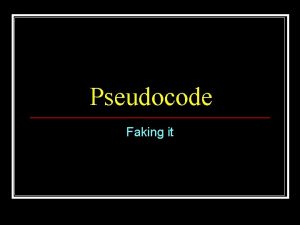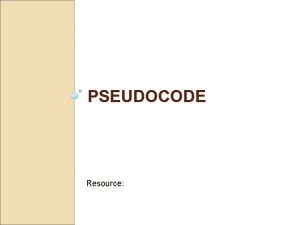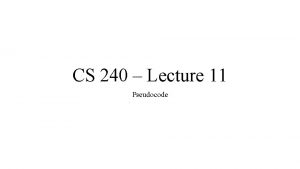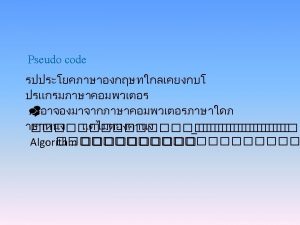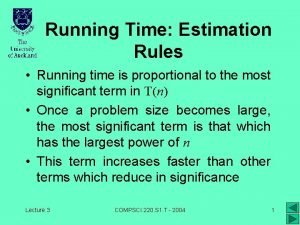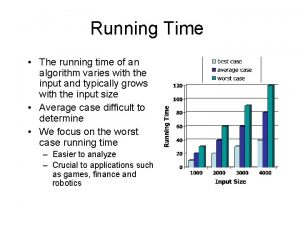Analysis of Algorithms Running Time PseudoCode Analysis of



















- Slides: 19

Analysis of Algorithms • Running Time • Pseudo-Code • Analysis of Algorithms • Asymptotic Notation • Asymptotic Analysis • Mathematical facts Analysis of Algorithms 1

Average Case vs. Worst Case Running Timeof an algorithm • An algorithm may run faster on certain data sets than on others. • Finding the average case can be very difficult, so typically algorithms are measured by the worst-case time complexity. • Also, in certain application domains (e. g. , air traffic control, surgery, IP lookup) knowing the worst-case time complexity is of crucial importance. Analysis of Algorithms 2

Measuring the Running Time • How should we measure the running time of an algorithm? • Approach 1: Experimental Study – Write a program that implements the algorithm – Run the program with data sets of varying size and composition. – Use a method like System. current. Time. Millis() to get an accurate measure of the actual running time. Analysis of Algorithms 3

Beyond Experimental Studies • Experimental studies have several limitations: – It is necessary to implement and test the algorithm in order to determine its running time. – Experiments can be done only on a limited set of inputs, and may not be indicative of the running time on other inputs not included in the experiment. – In order to compare two algorithms, the same hardware and software environments should be used. Analysis of Algorithms 4

Beyond Experimental Studies • We will now develop a general methodology for analyzing the running time of algorithms. In contrast to the "experimental approach", this methodology: – Uses a high-level description of the algorithm instead of testing one of its implementations. – Takes into account all possible inputs. – Allows one to evaluate the efficiency of any algorithm in a way that is independent from the hardware and software environment. Analysis of Algorithms 5

Pseudo-Code • Pseudo-code is a description of an algorithm that is more structured than usual prose but less formal than a programming language. • Example: finding the maximum element of an array. Algorithm array. Max(A, n): Input: An array A storing n integers. Output: The maximum element in A. current. Max A[0] for i 1 to n -1 do if current. Max < A[i] then current. Max A[i] return current. Max • Pseudo-code is our preferred notation for describing algorithms. • However, pseudo-code hides program design issues. Analysis of Algorithms 6

What is Pseudo-Code ? • A mixture of natural language and high-level programming concepts that describes the main ideas behind a generic implementation of a data structure or algorithm. -Expressions: use standard mathematical symbols to describe numeric and boolean expressions -use for assignment (“=” in Java) -use = for the equality relationship (“==” in Java) -Method Declarations: -Algorithm name(param 1, param 2) -Programming Constructs: - decision structures: if. . . then. . . [else. . . ] - while-loops: - repeat-loops: - for-loop: - array indexing: -Methods: Analysis of Algorithms while. . . do repeat. . . until. . . for. . . do A[i] - calls: object method(args) - returns: return value 7

Analysis of Algorithms • Primitive Operations: Low-level computations independent from the programming language can be identified in pseudocode. • Examples: – calling a method and returning from a method – arithmetic operations (e. g. addition) – comparing two numbers, etc. • By inspecting the pseudo-code, we can count the number of primitive operations executed by an algorithm. 8

Example: Algorithm array. Max(A, n): Input: An array A storing n integers. Output: The maximum element in A. current. Max ¨ A[0] for i ¨ 1 to n -1 do if current. Max < A[i] then current. Max A[i] return current. Max Analysis of Algorithms 9

Asymptotic Notation • Goal: to simplify analysis by getting rid of unneeded information (like “rounding” 1, 000, 001≈1, 000) • We want to say in a formal way 3 n 2 ≈ n 2 • The “Big-Oh” Notation: – given functions f(n) and g(n), we say that f(n) is O(g(n) ) if and only if there are positive constants c and n 0 such that f(n)≤ c g(n) for n ≥ n 0 Analysis of Algorithms 10

Example For functions f(n) and g(n) (to the right) there are positive constants c and n 0 such that: f(n)≤c g(n) for n ≥ n 0 conclusion: 2 n+6 is O(n). Analysis of Algorithms 11

Another Example On the other hand… n 2 is not O(n) because there is no c and n 0 such that: n 2 ≤ cn for n ≥ n 0 (As the graph to the right illustrates, no matter how large a c is chosen there is an n big enough that n 2>cn ). Analysis of Algorithms 12

Asymptotic Notation (cont. ) • Note: Even though it is correct to say “ 7 n - 3 is O(n 3)”, a better statement is “ 7 n - 3 is O(n)”, that is, one should make the approximation as tight as possible • Simple Rule: Drop lower order terms and constant factors 7 n-3 is O(n) 8 n 2 log n + 5 n 2 + n is O(n 2 log n) Analysis of Algorithms 13

Asymptotic Notation (terminology) • Special classes of algorithms: logarithmic: O(log n) linear: O(n) quadratic: O(n 2) polynomial: O(nk), k ≥ 1 exponential: O(an), n > 1 • “Relatives” of the Big-Oh – (f(n)): Big Omega--asymptotic lower bound – (f(n)): Big Theta--asymptotic tight bound Analysis of Algorithms 14

Asymptotic Analysis of The Running Time • Use the Big-Oh notation to express the number of primitive operations executed as a function of the input size. • For example, we say that the array. Max algorithm runs in O(n) time. • Comparing the asymptotic running time -an algorithm that runs in O(n) time is better than one that runs in O(n 2) time -similarly, O(log n) is better than O(n) -hierarchy of functions: log n << n 2 << n 3 << 2 n • Caution! Beware of very large constant factors. An algorithm running in time 1, 000 n is still O(n) but might be less efficient on your data set than one running in time 2 n 2, which is O(n 2) 15

Example of Asymptotic Analysis An algorithm for computing prefix averages Algorithm prefix. Averages 1(X): Input: An n-element array X of numbers. Output: An n -element array A of numbers such that A[i] is the average of elements X[0], . . . , X[i]. Let A be an array of n numbers. for i 0 to n - 1 do a 0 for j 0 to i do a a + X[j] 1 step A[i] a/(i+ 1) return array A • Analysis. . . i iterations with i=0, 1, 2. . . n-1 n iterations 16

Another Example • A better algorithm for computing prefix averages: Algorithm prefix. Averages 2(X): Input: An n-element array X of numbers. Output: An n -element array A of numbers such that A[i] is the average of elements X[0], . . . , X[i]. Let A be an array of n numbers. s 0 for i 0 to n do s s + X[i] A[i] s/(i+ 1) return array A • Analysis. . . Analysis of Algorithms 17

Math You Need to Review Logarithms and Exponents (Appendix A, p. 617) • properties of logarithms: logb(xy) = logbx + logby logb (x/y) = logbx - logby logbxa = alogbx logba= logxa/logxb • properties of exponentials: a(b+c) = aba c abc = (ab)c ab /ac = a(b-c) b = a logab bc = a c*logab Analysis of Algorithms 18

More Math to Review • Floor: x = the largest integer ≤ x • Ceiling: x = the smallest integer ≥ x • Summations: (see Appendix A, p. 619) • Geometric progression: (see Appendix A, p. 620) Analysis of Algorithms 19
 Once upon a time there lived a little country girl
Once upon a time there lived a little country girl Running running running
Running running running Expressing algorithms
Expressing algorithms Running time analysis
Running time analysis Undecidable problems and unreasonable time algorithms.
Undecidable problems and unreasonable time algorithms. Time complexity for algorithms
Time complexity for algorithms Undecidable problems and unreasonable time algorithms
Undecidable problems and unreasonable time algorithms Inplace heap sort
Inplace heap sort Expected running time of randomized algorithm
Expected running time of randomized algorithm Asymptotic running time
Asymptotic running time Running time algoritma
Running time algoritma Running time adalah
Running time adalah Running time table
Running time table Magentasum.com
Magentasum.com Its time to start running
Its time to start running Example of elapsed time
Example of elapsed time 1001 design
1001 design Algorithm analysis examples
Algorithm analysis examples What is analysis of algorithm
What is analysis of algorithm Association analysis: basic concepts and algorithms
Association analysis: basic concepts and algorithms


